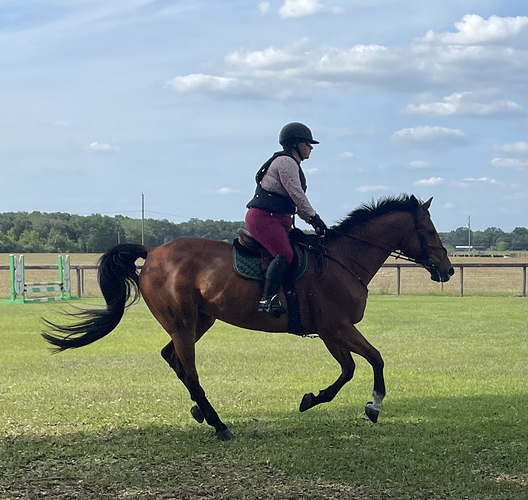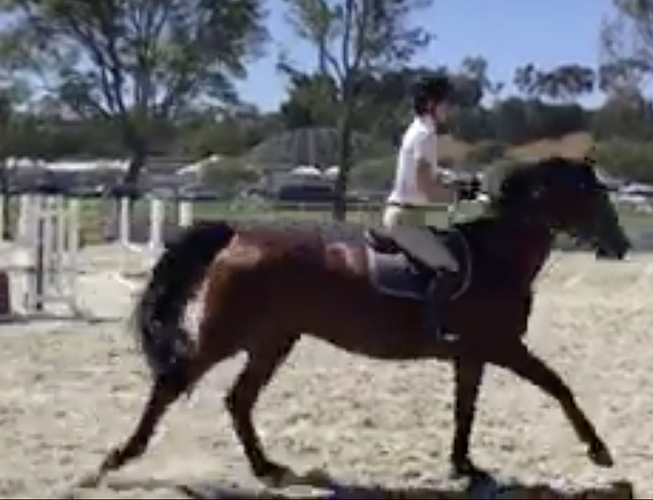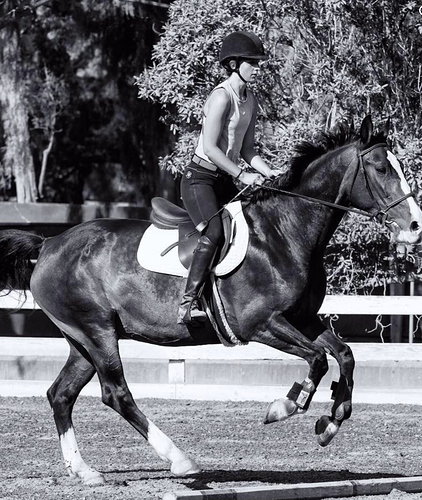I have been trying very hard to be softer in practice and at shows, but when I watch videos of myself (in either place), I see myself at least twice on course going from light and smooth contact to grabby for no apparent reason, other than me being about 5 strides away from the jump: horse is quiet and turns well, goes in a rubber snaffle. Worse part is that the horse has a very sensitive mouth and opens it with anything other than a light consistent contact. Has anyone an exercise that has helped them become more aware of their hands on the approach to the jump (about 5 strides away), or something they tell themselves while riding to the jump to keep a relaxed and consistent contact? This is in the context of the hunters. Thank you!
Have you tried riding with a jumping bat across both hands? I’ll try to find a pic but basically you pick up your reins as normal, and then each end of a bat under your thumbs. It keeps your hands even and teaches riders to ride more off the leg (and use the outside rein!), but it also prevents you from really grabbing backwards. You can’t shorten the reins or grab one very easily. I’ve found it really helps with getting the feel of quiet hands.
One hand in the mane/braids right above martingale strap, about 3-5 strides out… gives you one hand for steering/guidance and you have to sink into your tack in order to not get lawn-darted.
Works like a charm. We do it often in warm-up rings where I find myself riding too far ahead or grabbing a few strides out and needing one less. I do it on course when I’m coming down to a big 2 stride… keeps me riding up and forward and lessens the chance of me missing to the “in”… and I usually hold that position and balance through the 2-fence line and land still with braids in my hand and following with other rein/hand.
Also, riding with your hands in driving rein position (basically flipped over - rein goes from bit to between your forefinger and thumb, and runs down through your hand). It’s almost impossible to pull/yank or lift too high with the hand in this position! It can help you overcome the fear/anxiety of the jump that usually comes with this type of thing before the fence - even if you’re not “scared”, you are anticipating or reacting to the fence.
Was fortunate enough to participate in an Anne K clinic. These are helpful.
I was taught driving reins, but also a take on knotted reins…
bridge your reins with a loop in them to the bit in your outside hand. hold your inside arm straight out in front of you where your shoulder is even with your finger tips.
do this over fences - over a single or through a line on course, or eventually if you can do it through corners, too.
you end up super focused on keeping your arm straight and level with your shoulder, using your legs to steer, that you just float the bridged rein as you really cannot shorten or get grabby in that position.
yes, you hold that over the fence and jump it “with one hand” and sometimes eventually the whole course LOL.
this cover article photo is it.
What helps me is to change my count mantra from “1 - 2 - 3 - 4” to “1 - 2 - fo - llow” or “1 - 2 - a - llow”.
Wow, thank you all so much, I really appreciate your answers, I can’t wait to try these exercises! Thank for your time to explain them.
I take the Lucinda Green approach: ELBOW. Energy, line, balance and ow if you don’t.
Really though, get those things and leave your horse alone. I have to tell myself to leave. him. alone.
Horses know how to jump, they don’t need our micromanagement. (Says the helicopter horse mom 

 ).
).
I remember a trainer friend telling one of her kids (and me, probably  ) to pretend her pony has stinky ears, and to push them away from her. This imagery was particularly helpful when the grabbing was accompanied by a pitching forward of the body over the grabby hands…
) to pretend her pony has stinky ears, and to push them away from her. This imagery was particularly helpful when the grabbing was accompanied by a pitching forward of the body over the grabby hands…
I am OBSESSED with my Correct Connect reins!! I bought them for my 19.1hh monster of a 6 year old because I am extremely cognizant of keeping my connection with him soft as I never need a horse that big to have any excuse to get heavy or to get an idea it’s possible. He schools in a high ported gag (super high palate and big tongue; loves the poll pressure and the tongue relief), so I want to be as gentle as possible with him. The difference these reins have made in my feel and in my connection when riding him is astounding. There is something very cool about being able to change the connection with a squeeze of your fist and the feeling of the pads in your hands and the amount of pressure on the pads is wild. Looking back, there were so many times I was using far more hand than I actually though I was!
My biggest concern with using these reins was transitioning back to standard reins for shows (he’s an eq horse who dabbles in the hunters), but surprisingly it was a lot smoother than I anticipated. The reins have made such a difference in our communication that it carries over seamlessly to showing in his pelham. I would strongly recommend trying a pair! Video attached is a quick clip of us doing some grid work with them. Might be a touch hard to see, but the connection is rock solid (and that is NOT one of my strong points!!)
IMG_4086
19.1 … I read that correctly, yes? Funny are you tall or is he slab sided because you look completely normally sized on him. He’s adorable and doesn’t look like 19.1 from video!
IMG_2316.heic (2.1 MB)
IMG_4015.HEIC (1018.4 KB)Yes, and I’m not tall! My leg comes barely down his (very slab-sided) sides. I have a very, very long torso, so it’s deceptive. I also think that because I’m heavy it makes me look like I fit him a bit better. It’s hard to prove height in a picture, but here are a few that might give some context!
The first HEIC image is me on Batman (the giant) and my 5’9" niece on Flanny who is 16.3. The next two are me on Batman and me on Flanny so you can see the difference in how I look on them. The last picture is Batman (photo left) with Kipper (photo right) who sticks at 17.3 and some change. That pasture block is a 1000 lb block of alfalfa and is approximately 4’ while the run is a slanted run-in where the short side is 10’ and the tall side is 12’. And if you still don’t believe it, but you’re ever in Ocala, stop by and say hi!! He’s quite impressive in person!
Wrap the reins around his neck and rebuckle them. Keeps you from slipping the reins, keeps the contact consistent.
Oh I didn’t mean to put you on the defensive, I believe you. It was more a massive complement that you stay with his movement really well.
Now in those stills - YES - okay you look tiny on him with your legs barely going past the saddle flaps, but that’s even more a testament to your ride, as I cannot imagine staying with a horse that my legs didn’t “physically wrap around”.
I’m 5’9, long torso ish I suppose but mostly just long everywhere and I tend to make everything from 17.2 and below look kinda small…
I would lesson on a trainer’s old 18.1 Eventer (he never went past Intermediate), I found him SO hard to “keep together” and always felt a little strange on him despite my own physical size.
17.1 / 17.2 and very ROUND Warmblood Gelding
16.1 but she is a tank of a Dutch WB mare
I had a very fussy TB who needed a steady hand going into jumps. My trainer had me use a neckstrap. Grab onto that until you get the hang of not pulling on the reins.
Want. Need.
Neck strap. Don’t leave the in gate or start box without one.
Use driving rein/hands. Flip the reins around like you would if you were driving a horse. Ride like this all the time when home.
Anne Kursinski’s clinic would be especially helpful with that issue.




